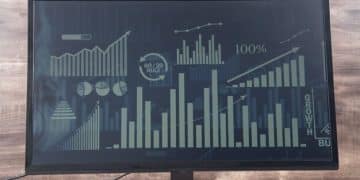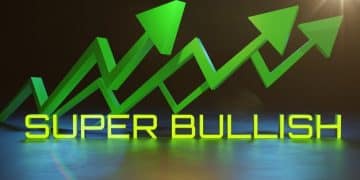US Unemployment Rate Drops to 3.7%: What It Means for Economy

The recent drop in the US unemployment rate to 3.7% signals a robust labor market and presents a nuanced picture for the economy, balancing opportunities for growth against potential inflationary pressures and shifts in monetary policy.
The news is out: the US unemployment rate has seen a significant dip to 3.7%. This figure is more than just a number; it’s a critical indicator of economic health, influencing everything from consumer spending to interest rates. Understanding what this latest US unemployment rate drops to 3.7% – what does this mean for the economy? requires a look beneath the surface, exploring its multifaceted implications for businesses, households, and monetary policy.
Understanding the Latest Unemployment Data
The latest announcement from the Bureau of Labor Statistics (BLS) indicates that the US unemployment rate has fallen to 3.7%. This is a notable development, suggesting a tightening labor market and continued resilience in the face of various economic headwinds. Such a low rate often represents full employment, a scenario where nearly everyone willing and able to work has a job.
To fully appreciate the significance of this percentage, it’s crucial to understand how unemployment is measured. The BLS conducts monthly surveys of households and businesses. The unemployment rate is derived from the household survey, which identifies individuals who are jobless, actively seeking work, and available to work. It excludes those who are not actively looking for employment, such as discouraged workers or those who have retired.
Historical Context and Trends
A 3.7% unemployment rate places the current labor market in a historically strong position. Over the past few decades, rates below 4% have been relatively rare, typically observed during periods of sustained economic expansion. For instance, before the COVID-19 pandemic, the unemployment rate reached a 50-year low, and the current figures are edging back towards those levels. This historical perspective suggests fundamental strength in job creation and retention.
The trend over the last year has shown a gradual, sometimes volatile, but generally downward trajectory in unemployment. This indicates a consistent demand for labor across various sectors, even as the economy navigates inflation, interest rate hikes, and global uncertainties. The consistent decline points to underlying robustness rather than a temporary anomaly.
Key Demographic Shifts
While the aggregate number is important, disaggregating the unemployment rate by demographic groups provides a richer picture. Unemployment rates can vary significantly across different races, genders, age groups, and educational attainment levels. For example, a low overall rate might still mask higher unemployment among specific minority groups or younger workers entering the labor force. Analyzing these specific breakdowns helps identify if the benefits of a strong labor market are broadly distributed or concentrated within certain segments of the population.
Moreover, the labor force participation rateâthe proportion of the population that is either employed or actively looking for workâis another critical metric. A low unemployment rate coupled with a declining participation rate could suggest that fewer people are interested in working, which might not be an entirely positive sign for long-term economic growth. Conversely, a low unemployment rate alongside a stable or rising participation rate points to a truly robust job market where more people are engaged.
The 3.7% figure is impressive on its own, but its detailed implications hinge on a deeper dive into the specific sectors experiencing growth, the quality of jobs being created, and the demographic groups benefiting most from this strong labor market. This nuanced understanding is essential for policymakers and analysts alike.
Impact on Wages and Inflation Dynamics
The relationship between a low unemployment rate, wage growth, and inflation is one of the most closely watched aspects of economic performance. Conventional economic theory, often articulated through the Phillips Curve, suggests that when unemployment is low, competition for workers intensifies, leading to higher wages. These increased labor costs can then be passed on to consumers in the form of higher prices, contributing to inflation.
Wage Growth Pressures
With unemployment at 3.7%, the labor market is undoubtedly tight. Businesses are likely finding it more challenging to attract and retain talent, particularly for skilled positions. This scarcity of labor typically puts upward pressure on wages. While higher wages are beneficial for workers as their purchasing power increases, they can also become a significant factor in driving core inflation, especially if productivity growth doesn’t keep pace.
Recent data indicates that wage growth has been strong, though it varies by sector and skill level. Industries facing acute labor shortages, such as healthcare or certain technology fields, are seeing substantial pay increases. This contributes to a broader trend where workers, emboldened by robust job opportunities, may demand better compensation and benefits. The challenge for policymakers is to discern whether this wage growth is sustainable and productive, or if it risks embedding inflationary expectations into the economy.
Inflationary Concerns and Consumer Spending
The primary concern arising from a very low unemployment rate, particularly in the current economic climate, is its potential to fuel inflation. If consumers have more disposable income due to higher wages and stable employment, their demand for goods and services is likely to increase. If supply cannot meet this increased demand, prices will rise. This demand-pull inflation can be persistent and difficult to curb once it takes hold.
Monitoring consumer spending patterns becomes crucial in this environment. Strong retail sales and increased credit card usage might indicate robust consumer confidence, but they also signal potential inflationary pressures. The Federal Reserve, therefore, pays close attention to both employment and inflation data, striving to achieve a dual mandate of maximum employment and price stability. The current tight labor market complicates this task, as efforts to cool inflation through monetary policy risk dampening job growth.
Productivity and Its Role
Another factor in the wage-inflation dynamic is productivity. If wage increases are matched by increased worker productivityâmeaning each worker produces more goods or servicesâthen businesses can absorb higher labor costs without necessarily raising prices. This is the ideal scenario: strong wage growth without inflationary consequences. However, if productivity growth lags behind wage growth, then the inflationary impact is more pronounced.
Understanding the interplay between unemployment, wages, inflation, and productivity is central to assessing the overall health and future trajectory of the economy. A 3.7% unemployment rate, while a testament to a strong job market, introduces complexities that require careful balancing acts from economic policymakers.
Implications for Monetary Policy and the Federal Reserve
The Federal Reserve’s decisions are heavily influenced by economic indicators like the unemployment rate and inflation. With the unemployment rate dropping to 3.7%, the Fed faces a complex situation as it pursues its dual mandate: ensuring maximum employment and maintaining price stability. A tight labor market, while desirable for job seekers, often suggests that inflationary pressures could persist or intensify.
Interest Rate Outlook
A lower unemployment rate generally gives the Federal Reserve more flexibility to continue with, or even deepen, its restrictive monetary policy. If the labor market remains strong, it suggests the economy can withstand higher interest rates and that the Fed has more room to fight inflation without triggering a recession. The Fed’s primary tool for combating inflation is raising the federal funds rate, which influences borrowing costs across the economy.
The 3.7% figure will likely strengthen the case for the Fed to maintain a hawkish stance, potentially signaling that rate cuts are not imminent or that further hikes, though less likely, are still on the table if inflation proves stubborn. Market participants will be closely watching the Fed’s upcoming statements for any subtle shifts in language regarding future rate decisions, as a strong labor market might reduce the urgency for rate reductions.

Balancing Inflation Control and Economic Growth
The challenge for the Fed lies in balancing the need to control inflation, which has been elevated, with the desire to avoid stifling economic growth. A robust labor market, while a sign of health, can contribute to demand-pull inflation. If the Fed tightens monetary policy too aggressively, it risks pushing the economy into a recession and causing job losses. Conversely, if it eases too soon, it could allow inflation to re-accelerate, eroding purchasing power.
The current unemployment rate provides the Fed with a valuable data point that indicates underlying economic strength. This strength allows the Fed to focus more intently on its inflation target, given that the employment side of its mandate appears to be well-supported. However, the exact path forward will depend on a confluence of other factors, including consumer spending, global economic conditions, and geopolitical events.
Quantitative Tightening and Balance Sheet Reduction
Beyond interest rates, the Fed is also engaged in quantitative tightening (QT), where it reduces its balance sheet by allowing maturing bonds to roll off without reinvesting the proceeds. This process pulls liquidity out of the financial system, putting further upward pressure on long-term interest rates and tightening overall financial conditions. A strong job market could reassure the Fed that it can continue or even accelerate QT, as the economy seems capable of absorbing the reduction in liquidity.
The confluence of a very low unemployment rate and persistent inflationary pressures suggests that the Federal Reserve will continue its data-dependent approach, with a strong leaning towards keeping monetary policy TIGHT enough to bring inflation back to its 2% target. The 3.7% unemployment rate complicates the narrative, providing both a sign of resilience and a source of potential concern for price stability.
Sector-Specific Impacts and Industry Trends
While a national unemployment rate of 3.7% paints a broad picture of a strong labor market, the reality on the ground often varies significantly by industry. Certain sectors may be experiencing robust hiring and wage growth, while others might be facing stagnation or even layoffs. Understanding these sector-specific trends is crucial for a comprehensive economic analysis.
Growth Sectors and Job Creation
Several sectors are consistently showing strength in job creation. Technology, despite recent layoffs in some prominent companies, continues to be a growth engine for many specialized roles, particularly in emerging areas like AI, cybersecurity, and data science. Healthcare is another sector with enduring demand, driven by an aging population and advancements in medical technology. Jobs in nursing, home health care, and specialized medical fields consistently show low unemployment rates and strong hiring.
The leisure and hospitality sector, after a significant setback during the pandemic, has also seen a strong rebound, contributing significantly to overall job growth. Similarly, professional and business services, encompassing areas like consulting, accounting, and legal services, tend to perform well in an expanding economy, providing high-value jobs. The strength in these areas helps absorb workers and keep the overall unemployment rate low. These areas reflect diverse economic activities, from high-tech innovation to essential services, signaling broad-based job expansion.
Challenges and Declining Sectors
Conversely, some sectors may not be benefiting as much from the low unemployment rate, or they might even be contracting. Manufacturing, for instance, faces ongoing challenges from automation, global competition, and supply chain disruptions. While certain specialized manufacturing roles may be in demand, overall employment in this sector can be volatile. Retail, particularly brick-and-mortar stores, continues to undergo transformations due to e-commerce, leading to job shifts rather than pure growth.
Moreover, sectors heavily reliant on interest-rate sensitive activities, such as real estate and construction, might experience slowdowns as the Federal Reserve maintains higher interest rates. While a strong labor market generally supports housing demand, elevated borrowing costs can cool activity in these areas, affecting employment. The nuances within each sector provide a more granular view of economic health, revealing pockets of stress despite overall positive figures.
Skill Gaps and Workforce Development
Even with a low unemployment rate, skill gaps remain a significant challenge for many businesses. Employers in high-growth sectors often struggle to find candidates with the specific technical or specialized skills they require. This phenomenon, often referred to as a “skills mismatch,” means that even if there are job openings, unemployed individuals may not possess the qualifications needed for those roles. This leads to extended hiring times and increased training costs for companies.
Addressing these skill gaps is critical for maintaining long-term economic growth and ensuring that the benefits of a strong labor market are widely shared. Initiatives in workforce development, vocational training, and continuous education are essential to equip workers with the skills demanded by evolving industries. This proactive approach ensures that the low unemployment rate is sustainable and reflective of well-matched talent and abundant opportunities across the economic spectrum.
Consumer Confidence and Spending Behavior
The unemployment rate is a powerful psychological indicator for consumers. When people feel secure in their jobs and see ample opportunities for employment, their confidence tends to rise. This heightened consumer confidence typically translates into increased spending, which is a major driver of economic growth.
Impact on Consumer Confidence
A 3.7% unemployment rate significantly boosts consumer confidence. Individuals are less worried about job security, making them more comfortable with major purchases like homes, cars, or embarking on significant investments. This sense of stability can also reduce precautionary savings, as people feel less need to squirrel away money for potential job loss.
Confidence data, such as the Consumer Confidence Index, often correlates closely with unemployment figures. When the job market is strong, consumers generally feel optimistic about their financial futures and the broader economy. This positive sentiment creates a virtuous cycle: confidence leads to spending, which fuels economic activity, leading to more job creation and even greater confidence.
Shifts in Spending Patterns
Increased consumer confidence and disposable income (due to higher wages from a tight labor market) can lead to shifts in spending patterns. Discretionary spending, on items like dining out, travel, entertainment, and luxury goods, tends to rise. This benefits sectors that were hit hard during economic downturns, such as leisure and hospitality.
However, the current economic climate also involves elevated inflation. While a strong job market provides income, rising prices can erode purchasing power. Consumers might adjust their spending to prioritize essential goods and services, even if they feel confident about their employment. The interplay between strong employment and high inflation creates a complex dynamic for consumer behavior, where people may spend more but get less for their money.
Credit and Debt Implications
A robust job market can also influence consumer borrowing and debt levels. With secure employment, consumers might be more willing to take on new loans, such as mortgages or auto loans, or increase their credit card usage. This can stimulate further economic activity, but it also carries risks if interest rates are high or if consumers overextend themselves. Lenders, too, might be more willing to offer credit to employed individuals, seeing them as lower risk.
While increased borrowing can signify economic confidence, a careful watch on household debt levels is always warranted. A balance must be struck where consumers can leverage their strong employment for financial advancement without accumulating unsustainable debt loads. The 3.7% unemployment rate fundamentally underpins a sense of financial stability for many, allowing them to make larger financial decisions and contribute to the vibrant flow of the economy.
Global Economic Context and Trade Implications
The US economy does not operate in isolation. Its strength, particularly in the labor market, has significant implications for global trade, international investment flows, and the economic performance of other nations. A strong US job market can both benefit and challenge the global economy.
Impact on Global Demand and Trade Partners
A healthy US economy, characterized by low unemployment and robust consumer spending, typically translates into higher demand for goods and services from abroad. As American consumers and businesses purchase more, this directly benefits countries that are major exporters to the US. Trade partners, from manufacturing hubs in Asia to raw material suppliers, often experience increased activity and economic growth as a result of strong US demand.
This increased demand can lead to higher import volumes, strengthening global supply chains and fostering international trade relationships. For countries reliant on exports to the US, a low unemployment rate here provides a stable and lucrative market, contributing to their own employment and economic stability. Therefore, the 3.7% rate in the US is likely viewed positively by many of its major trading partners.

Currency Strength and Investment Flows
A strong US economy, buttressed by a tight labor market and potentially leading to higher interest rates (if the Fed continues a hawkish stance), tends to strengthen the US dollar. A stronger dollar makes US imports cheaper but US exports more expensive for foreign buyers. This can be a mixed blessing: while it helps combat imported inflation, it might also make American goods less competitive on the global stage, potentially affecting export-oriented industries.
Furthermore, a strong US economy attracts foreign direct investment (FDI). International companies are more likely to invest in a market with high consumer demand, a stable political environment, and a skilled workforce. This influx of foreign capital can further stimulate economic growth, create jobs, and foster technological advancements within the US, benefiting both domestic and international investors.
Inflationary Spillover and Policy Coordination
The inflationary pressures experienced in the US, partly driven by a tight labor market, can have spillover effects globally. If US demand fuels higher commodity prices or strains global supply chains, other countries might experience imported inflation. This complex interplay often necessitates greater policy coordination among central banks and international financial institutions.
Moreover, similar to the US, other nations are also grappling with inflation and tight labor markets to varying degrees. The US Federal Reserve’s monetary policy decisions, heavily influenced by its domestic unemployment rate, can set a precedent or at least influence the decisions of other central banks globally. This interconnectedness means that a 3.7% unemployment rate in the US is not just a domestic affair but a significant data point in the broader tapestry of the global economy.
Potential Risks and Challenges Ahead
While a 3.7% unemployment rate is largely a positive indicator, it doesn’t mean the US economy is free from risk. Several potential challenges and headwinds could emerge, impacting the sustainability of this strong labor market and the broader economic outlook.
The Risk of Overtightening by the Fed
One of the most significant risks is the possibility of the Federal Reserve overshooting its policy tightening. If the Fed continues to raise interest rates or maintains them at elevated levels for too long in an effort to combat inflation, it could inadvertently push the economy into a recession. This “hard landing” scenario would lead to job losses and an increase in the unemployment rate, undoing the progress made.
The challenge for the Fed is to find the delicate balance between bringing inflation down to its target and avoiding a severe economic contraction. The 3.7% unemployment rate gives the Fed more room to maneuver, but it also increases the stakes, as aggressive tightening could quickly reverse the positive employment trends.
Geopolitical Instability and Supply Chain Disruptions
External factors, such as ongoing geopolitical conflicts, energy price shocks, or renewed supply chain disruptions, pose considerable risks. Events in one part of the world can have ripple effects across global markets, influencing everything from raw material costs to consumer demand. A new wave of disruptions could reignite inflationary pressures, even if domestic employment remains strong, forcing the Fed into difficult policy choices.
Dependence on global supply chains means that unforeseen events in other countries can quickly transmit volatility to the US economy, affecting production, prices, and ultimately, employment stability. The resilience of the job market can be tested if these external shocks are severe and prolonged.
Lagging Effects of High Interest Rates
The full impact of past interest rate hikes may not have been completely felt across the economy yet. Monetary policy operates with a lag, meaning it takes time for rate changes to filter through the financial system and affect consumer and business behavior. We might still see some sectors, particularly those sensitive to borrowing costs, experience a slowdown in the coming months, which could lead to gradual job losses even with a low headline unemployment rate.
Businesses that have deferred investment plans due to high borrowing costs or consumers who have delayed large purchases might eventually trigger a broader slowdown. Monitoring these lagging indicators is crucial for anticipating future shifts in the labor market.
Demographic Shifts and Labor Force Participation
Long-term demographic trends also present challenges. An aging population and declining birth rates could lead to a shrinking labor force over time, making it difficult to sustain robust economic growth. While a low unemployment rate is great in the short term, a declining labor force participation rate can signal deeper structural issues that limit the economy’s productive capacity in the long run.
Addressing these demographic shifts, perhaps through immigration policies or initiatives to encourage older workers to remain in the workforce, will be vital for future labor market stability. The 3.7% unemployment rate, while a current triumph, must be viewed with an eye towards these potential future hurdles and the policies needed to navigate them effectively.
| Key Point | Brief Description |
|---|---|
| ✅ Labor Market Strength | Unemployment at 3.7% indicates a robust and tight job market, nearing full employment levels. |
| 💲 Wage and Inflation Impact | Low unemployment often leads to wage growth, potentially contributing to inflationary pressures. |
| 🏛️ Federal Reserve Response | A strong job market gives the Fed more room for restrictive policies to combat inflation. |
| 🌍 Global Implications | US labor strength impacts global demand, trade, currency values, and may cause economic spillovers. |
Frequently Asked Questions About the US Unemployment Rate
A 3.7% unemployment rate suggests a strong, tight labor market, often considered near “full employment.” It indicates that most people who want jobs can find them, fostering economic stability and consumer confidence, but it can also signal potential inflationary pressures due to increased wage competition and consumer demand. This is generally seen as a positive economic indicator.
A consistently low unemployment rate typically gives the Federal Reserve more flexibility to maintain or even raise interest rates without fear of harming the employment mandate. This is because a strong job market can withstand higher borrowing costs, allowing the Fed to focus more on curbing inflation, which often accompanies tight labor markets. It suggests less urgency for rate cuts.
While generally positive, a very low unemployment rate can lead to increased competition for workers, driving up wages and potentially contributing to inflation if productivity does not keep pace. It might also indicate a skills gap, where employers struggle to find qualified candidates, or lead to over-tightening of monetary policy by the central bank, risking a recession.
Sectors that are typically sensitive to consumer spending, such as retail, hospitality, and entertainment, often see increased demand and hiring. Additionally, high-growth sectors like technology and healthcare tend to thrive, along with professional and business services, as increased economic activity generates more demand for their expertise. These sectors collectively drive job creation.
For the average American household, a low unemployment rate generally means greater job security, more opportunities for career advancement, and potentially higher wages. This fosters stronger consumer confidence, encouraging spending on goods and services, and improving overall financial well-being. However, the benefits might be partially offset if high inflation erodes purchasing power.
Conclusion
The drop in the US unemployment rate to 3.7% is a robust testament to the underlying strength of the American labor market. This figure signals a period of high employment, benefiting workers through increased job security and potential wage growth. For businesses, it reflects a vibrant economy, though it also points to intensified competition for talent. The Federal Reserve will undoubtedly weigh this strong employment data heavily as it navigates its monetary policy, balancing inflation control with economic growth. While the road ahead presents potential challenges from geopolitical shifts and the lagged effects of policy decisions, the current unemployment rate provides a strong foundation for continued economic activity, shaping everything from consumer behavior to global trade dynamics.





